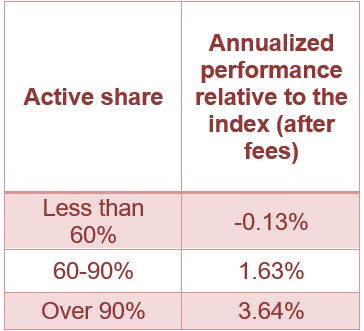Smith Falconer Financial Group
October 08, 2023
Active share
In periods of stock market volatility, many investors debate the merits of actively managed funds with returns that look different than their benchmark index. In focusing on short-term underperformance (and the management fees that are being paid), investors overlook that active management is necessary in achieving long-term outperformance relative to the benchmark index. This can only be achieved when the portfolio managers of actively managed funds make disciplined decisions based on insights uncovered through extensive due diligence.
Interestingly, over half of investment strategies in Canada that are considered “active”, still closely follow the index. This means that an investor pays a management fee for a return that they could have achieved by simply investing in a lower-cost index fund.
In order to participate in true active management, investors can look to understand a fund’s active share. Active share is calculated as the percentage of a fund that differs from the benchmark index. A fund with 100% active share would have no benchmark overlap, whereas a fund with 0% active share would be identical to the index.
In practice, an active equity fund manager can only look to achieve outperformance (in excess of fees), by being different from the benchmark index. The below chart suggests that investors are better off investing with active managers that have an active share of at least 60%.

Source: Cremers, M., Ferreira, M., Matos, P. and Starks, L., “The Mutual Fund Industry Worldwide: Explicit and Closet Indexing, Fees, and Performance,” Social Science Research Network, 2013.
However, active share should not be considered an indication that a fund will outperform. Taking positions that are different from the benchmark index is the first step, but the success of those decisions is the second step to outperformance that is not measured in the active share statistic. Understanding an investment manager’s investment process and conviction in their strategy is crucial to making informed decisions when investing in actively managed funds.
Smith Falconer Financial Group routinely meets with portfolio managers to do just that. We ensure that our carefully selected “roster” of recommended funds are actively managed, and leverage this time to thoroughly understand their investment strategies and performance criteria. This allows us to build portfolios tailored to each clients’ objectives. We believe in the long-run, the inclusion of actively managed funds in a customized plan achieves our clients’ goals.
Sources:
Cremers, M., Ferreira, M., Matos, P. and Starks, L., “The Mutual Fund Industry Worldwide: Explicit and Closet Indexing, Fees, and Performance,” Social Science Research Network, 2013.
Cremers, M. and Petajisto, A. “How Active is Your Fund Manager? A New Measure That Predicts Performance”” Yale School of Management, 2009.
EdgePoint Wealth Management Inc. “Sizing up active management”. https://edgepointwealth.com/article/sizing-up-active-management/




